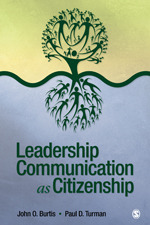Leadership Communication as Citizenship
no information available
Leadership Communication articulates the important roles communication plays in helping tco-construct group, organizational, or community direction Leadership Communication focuses on the communication skills necessary thelp co-construct an effective direction in ones systems while playing the varied roles of doer, follower, guide, manager, andor leader Leadership Communication is organized around three major units: 1) the integrally linked role played by communication and direction-givers in constructing our past, current, and future experiences; 2) the communication skills required for different types of direction-givers, and 3) the nature of dramatic action, which represents human engagement in systems, that may manifest as ethical action and future experiences This book has a number of unique features including: a coherent and unified set of frameworks with which tsynthesize and employ a wide range of leadership research results and theory as well as other practical materials from contemporary leadership studies; a focus on explaining the common communicative elements and skills (eg, soliciting and saving narratives for use as teaching tales, strategic stories, and memorable messages; framing and critical incidents; dialog, discussion, and debate) involved across seemingly quite different leadership contexts (eg, working in groups, in small organizations, in large and complex organizations, in social movements, in communities, and in the broad cultural sweep of civic life); a discussion of the different processes for attaining a direction-giving role or position given the different needs faced by the system; an explanation of the art of following, doing, and guiding well: the small leadership soften overlooked or undervalued in leader-centric explanations for effective systems; an explanation of three different orientations for communicating the vision: selling a vision; working with those whare seeking a vision; and acting with those for whom a vision is an evoked co-construction; and a discussion of how crisis (as a point of decision or of opportunity) can be useful as a source of the energy and rhetorical resources necessary for rare and difficult forms of dramatic action (leadership) ... Read more Read less











